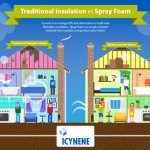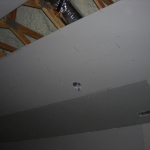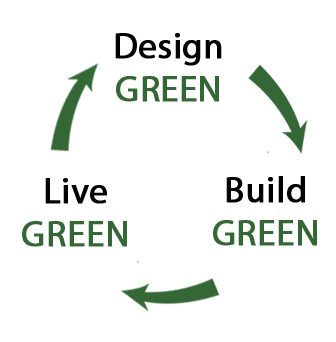by Sean | Feb 5, 2013 | Building Green, Green Building
Living Stone Construction understand the importance of using “spray foam” to insulate every home we build for many reasons, the most important being the energy efficiency Spray foam insulation offers numerous benefits that traditional cellulose or fiberglass insulation fail to provide. Here are a few of the reasons why this kind of insulation is an ideal, energy-efficient alternative to its counterparts.
- Spray foam insulation fills gaps
- Spray foam insulation expands up to 100 times its volume when it is applied to surfaces, filling gaps that might otherwise cause air leakage. Meanwhile, cellulose and fiberglass can be loosely packed, which can result in drafty spots or stuffy areas in a building.
- Spray foam insulation is healthier
- Spray foam insulation is eco-friendly and helps keep allergens and pollutants outside of homes and businesses.
Read More
by Sean | Jan 29, 2013 | News
Fireplaces, whether they are wood-burning or gas, are both fashionable and functional additions to many homes. Families gather around decorated hearths for holiday celebrations as they build lifelong memories. During the cooler winter months, fireplaces, wood stoves and other fuel-fired appliances are often used as primary heat sources in homes. But sadly, fireplace safety can be neglected, sometimes with tragic results. Everyone has seen the news stories about homes burned to the ground and lives lost due to improperly disposed-of fireplace ashes. According to the U.S. Fire Administration (USFA), heating fires account for 36 percent of residential home fires in rural areas every year. Here are some tips to make sure your fireplace remains a safe, enjoyable feature of your family’s home: Have your chimney thoroughly cleaned once a year. Flammable residue that accumulates in the flue can lead to fires in the chimney, and cracks or gaps in the flue can decrease the draft required both for combustion and to carry toxic gases away from your home. You can find a certified chimney specialist at csia.org. Use either a metal mesh screen or glass doors—or both—as a barrier between the fireplace and hearth. If you have glass doors, leave them open while burning a fire so that the fire receives enough air to ensure complete combustion and keeps creosote from building up in the chimney. Always keep the mesh screen closed when a fire is burning to keep embers or sparks from getting into the room. Never use flammable liquids to start a fire, or burn cardboard boxes, trash or debris in your fireplace. Use only seasoned hardwood, non-seasoned (or green) wood tends to smoke more and burn less efficiently, and can leave significantly more resin and soot in your chimney. Never burn any part of fir or pine trees in a fireplace. The sap can explode, and the needles can ignite quickly which could send sparks into the room or into the chimney where creosote deposits could catch fire. Never leave a fire unattended, and make sure the fire is completely out before going to bed or leaving the house. Douse and saturate ashes with water, and never empty ash directly into a trash can. Place completely cooled ashes in a tightly covered metal container and keep the container at least 10 feet away from any building. Cover the top of your chimney with a mesh screen spark arrester, and keep the roof clear of leaves, pine needles and other debris. Also cut away any branches that are hanging above the chimney. You can find more fire safety tips on USFA’s website at usfa.fema.gov. Taking these steps will help to ensure that the time you spend around your fireplace is enjoyable, and your family and home is safe.
by Sean | Jan 21, 2013 | Accreditation, Building Green, Green Building, Recognition
The U.S. green building market continues to accelerate, according to McGraw-Hill Construction’s 2013 Dodge Construction Green Outlook report. The value of green building has seen growth from $10 billion in 2005 to $78 billion in 2011. In 2012, the total market — non-residential and residential — is expected to be worth $85 billion, and by 2013, overall new green building is projected to rise to between $98 billion and $106 billion. By 2016, this number is expected to reach $204 billion to $248 billion.
Read More
by Sean | Jan 17, 2013 | Testimonials, What Customers Are Saying
LSC has been a major part in my tenure as a Certified Lighting Consultant/Administrative Assistant for as a major collaborative partner, Lux Lighting & Design.
We have worked on smaller ‘modest’ projects, to large-scale near “mansions”. The “thing” that sets LSC apart from many other builders I have encountered in my career is the meticulous and spectacular craftsmanship that is maintained throughout each and every project. Working closely with the LSC team, Owner Sean Sullivan and his team of professionals and incredibly knowledgeable Project Managers, that see the projects from start to finish, maintaining the excellent and almost seemingly proprietary craftsmanship, no matter the square footage of the project or the budget.
Read More
by Sean | Jan 14, 2013 | News
Top trends include the move toward clean, contemporary kitchen cabinets and the rise of quartz composite countertops. Here are Neil Kelly’s top trends for 2013, based on extensive input from the firm's 20-person design team: 10. Kitchen Cabinets A clean, simple, contemporary look will be popular with homeowners looking to economize and eliminate unnecessary clutter and fussy details that equate to high maintenance and complicated living. For those who don’t want to spring for new cabinetry, re-facing or refinishing cabinets offers more bang for the buck. 9. Countertops Granite has been dethroned. While granite isn’t going away and still has many die-hard fans, the new king of countertops will be quartz composite — the closest thing to no maintenance, bullet-proof countertop materials available today. 8. Hardwood Floors Pre-finished and engineered wood flooring will become more popular than the once gold-standard of site-finished flooring. Pre-finished woods provide a hard, durable finish, are an installation time saver, and eliminate the sanding dust dilemma. Engineered wood floors are also compatible with under-floor heating systems, a big plus in cold climates. 7. Glass Backsplashes Glass mosaic tile is on the way out. Taking its place are glass/stone/tile mosaic composites that can add more texture and visual interest and that tie in more readily with stone or quartz countertops. Be on the lookout for back-painted, solid glass panel backsplashes in contemporary settings, which provides an ultra-clean, almost ethereal look to a polished, modern kitchen setting. 6. Stylishly Simple Sinks Goodbye double-sinks, hello deep single-bowl sinks. With accessories such as fitted colanders and dish drains, deep single-bowl sinks have all the benefits of a divided sink, plus the large size to actually fit that roasting pan or those baking sheets into the sink all at once. Stainless is still popular, but the quartz composites are a great value and durable option. 5. Color Palette Charcoal is the new black. 2013 will find this silky color everywhere as it blends the right amount of chocolate, grey and a touch of green. 4. Bathroom Stone Synonymous with luxury, Calacatta marble will find its way into both traditional and contemporary bathrooms. Calacatta is a rarer stone than Carrara marble, but is quarried in the same region. It is valued for a whiter background and bolder grey veins. 3. Texture and Sparkle Bedazzled may find its way into home décor and design as homeowners seek a blend of classic textures and colors with pops of bold color and elements of sparkle. Glossy glass tile backsplashes and sparkle on polished nickel fixtures trend in 2013. 2. Living In Your Home Longer/Multi-Generational Living With many certified aging-in-place specialists (CAPS), Neil Kelly designers predict a growing trend to help aging baby boomers safely “grow old” in their homes, for as long as possible. Watch for easy kitchen and bath upgrades to enhance functionality, comfort and safety. 1. Healthy Home, Healthy Living Green and sustainable design is here to stay. The number one trend for 2013 will be to create a healthy living environment, free of toxins and harsh chemicals. More and more homeowners are taking advantage of federal and state incentives to evaluate their home’s energy efficiency and overall performance. Upgrade trends include the use of low VOC materials to improve indoor air quality, testing combustion safety, and radon mitigation.



